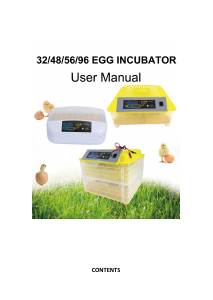© by WilTec Wildanger Technik GmbH Item 51185, 51186 Page 7
http://www.WilTec.de
http://www.aoyue.eu 03 2022-1
http://www.teichtip.de
8. What is to regard with the last days of the breeding process?
In the last two to three days before hatching, the poultry eggs must not only not be turned anymore, but
also does the entire incubator need to stay closed. For the humid-warm atmosphere needs to be pre-
served during the last days of the breeding to soften the egg membrane and enable the hatching pro-
cess.
Now you can choose if you wish to switch off the turning mechanism via the functional menu (therefore,
set the turning interval/turning duration to “0”) or to remove the whole turning insert. In case you remove
the turning insert, carefully open the device and take out the egg. Then place them on the bottom of the
device. Try to keep opening of the device as short as possible, then spray the eggs with warm (not
boiling!) water from a spray bottle. Thus, in most cases, the damp-warm climate inside the device will
be preserved.
Note: Most chicks are not able to cope with a complete collapse of the climate.
9. Poultry eggs: What happens after hatching?
Congratulations, your chicks have hatched! Have a little patience, as the freshly hatched chicks should
stay in the incubator for approx. 24 hours longer to be able to recover and dry off.
Important: Remove the water container. Otherwise, the humidity is too high for the chicks, and there is
the danger of the chicks drowning. However, you must develop a sure instinct for possible Johnnies-
come-lately still need humidity to hatch.
If these latecomers, pecking the egg from the inside, have difficulties getting through the eggshell, you
can provide a starting aid by carefully opening the eggshell a little bit. Certainly, a sure instinct is needed
as well in this condition for you must not help them too early. Oftentimes, a wrong humidity can be the
reason for that, as the egg membrane can dry and get stuck to the chick before it is able to get out.
Thus, the chick cannot turn any longer and hatch.
Note: There must be a sufficient fresh air flow, too, as the young animals can otherwise suffocate in the
closed container. If an integrated air hole is available, it will ensure for fresh air.
Operation
Before the eggs are placed in the incubator, regard the following:
• Open the packaging and check the content on integrity.
Note: The incubator should stay in the styrofoam packaging. This, on the one side helps save
energy, on the other side the eggs are protected from external influences. If there are no holes
for the according connections and switchboards, these need to be added. Carefully use a sharp
knife or small saw.
• Open the lid of the incubator and remove all included parts, except for the turning mechanism.
• In the lid of your incubator, you will find a connection point for the cable of the turning mecha-
nism, besides the thermometer and the humidity sensor. Place the cable of the turning motor of
the lower bit into this connection point, so that the turning mechanism is connected to the elec-
tricity circuit.
• If all cables are connected properly, check the compliance of the operating current as stated on
the device with the used mains voltage. If it matches, the device can be closed via the lid and
the electricity can be switched on. The device will start heating to the temperature, which is
analogously shown on the system’s switchboard.
• Leave the incubators run for at least 24 hours without any eggs inside and get accustomed to
the functions of the incubator. Make sure that all parameters can be adjusted without a problem
and how to change settings, such as the temperature alarm (regarding the paragraph “Display,
function buttons and basic settings”).












Praat mee over dit product
Laat hier weten wat jij vindt van de Wiltec 51185 Broedmachine. Als je een vraag hebt, lees dan eerst zorgvuldig de handleiding door. Een handleiding aanvragen kan via ons contactformulier.
beantwoord | Ik vind dit nuttig (0)